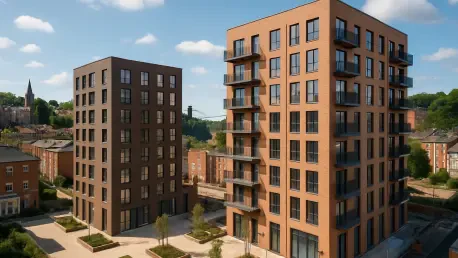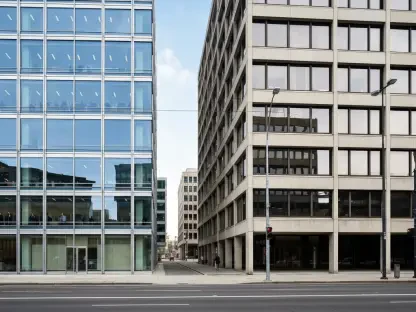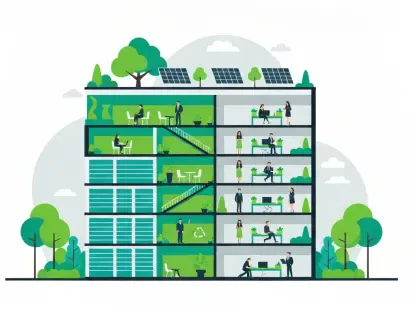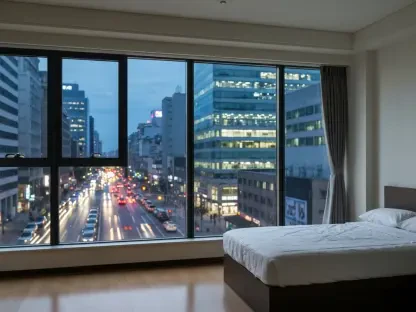Bristol, a city pulsating with cultural energy and historical depth, faces a critical juncture in its urban development as housing demand surges past supply, with over 470,000 residents straining the current infrastructure. Within this landscape, the £500 million Silverthorne Lane regeneration project in the Temple Quarter Enterprise Zone (TQEZ) emerges as a potential game-changer, particularly through Studio Hive’s approved development known as The Iron Works (Plots 2 and 3). Positioned near Bristol Temple Meads station, this 12-acre brownfield transformation aims to deliver 434 build-to-rent homes by 2029, alongside commercial spaces and community amenities. This analysis explores how this ambitious initiative could reshape Bristol’s real estate market, influence regional economic trends, and set a precedent for mixed-use urban projects. The focus lies on dissecting market dynamics, evaluating growth potential, and projecting long-term impacts on the city’s build-to-rent sector.
Diving Deep into Market Trends and Projections
Unpacking the Housing Crisis and Build-to-Rent Opportunities
Bristol’s housing market is under immense pressure, with rental demand soaring due to population growth and limited affordable options near central hubs. Studio Hive’s plan to introduce 434 build-to-rent units at The Iron Works addresses a critical gap, offering a spectrum of living spaces from studios to three-bedroom apartments. This segment of the market is poised for expansion as institutional investors increasingly view build-to-rent as a stable asset class, especially in cities with strong transport connectivity like Bristol. Data suggests that rental yields in urban centers could rise by 5-7% annually through 2027 if supply aligns with demand, though affordability remains a concern for lower-income brackets. The challenge lies in ensuring that such developments do not solely cater to higher earners, potentially skewing market accessibility.
Commercial Integration as a Catalyst for Economic Growth
Beyond residential offerings, The Iron Works incorporates commercial elements like workspaces, bars, and restaurants, creating a mixed-use ecosystem that could stimulate local economic activity. This trend mirrors successful urban models in other UK cities, where integrating leisure and business zones has boosted foot traffic and property values by up to 10% over five years. The inclusion of unique infrastructure, such as a water taxi stop for Bristol Ferry Boats and a waterside walkway along the Feeder Canal, positions the area as a lifestyle destination rather than just a residential hub. However, market risks include potential over-commercialization, which could dilute community focus if not carefully managed. Balancing these elements will be crucial for sustaining long-term investor interest and tenant retention in this evolving market.
Infrastructure Investments and Regional Market Spillover
The broader Silverthorne Lane masterplan extends its influence through significant infrastructure commitments, including a new 1,600-place secondary school (Oasis Academy Temple Quarter), student housing, and academic spaces for the University of Bristol. These additions cater to a diverse demographic, from families to young professionals, potentially increasing demand for rental properties by 15% in the Temple Quarter over the next few years. Unlike other regional projects, Bristol benefits from proximity to a major transport node, enhancing its appeal to investors eyeing high-growth areas. Market projections indicate that such holistic developments could inspire similar initiatives across the South West, with Studio Hive’s involvement in projects like the Weston-super-Mare Rugby Football Club site signaling broader regional impact. Yet, regulatory delays and funding constraints remain hurdles that could temper this momentum if not addressed.
Sustainability and Innovation Shaping Future Demand
Looking toward future market trends, sustainability and innovative design are becoming key differentiators in Bristol’s real estate sector. The Iron Works’ emphasis on waterside amenities and public spaces aligns with growing tenant preferences for environmentally conscious living, a factor that could drive rental premiums by 3-5% in mixed-use developments. Additionally, the build-to-rent model itself is evolving, with potential for technology-driven property management to enhance tenant experiences and operational efficiency. Investors are likely to prioritize projects that integrate smart urban planning, as evidenced by the Temple Quarter’s vision of blending transport, education, and residential zones. While economic uncertainties loom, the projected job creation tied to commercial spaces at Silverthorne Lane offers a buffer, potentially strengthening Bristol’s position as a leader in urban regeneration markets.
Reflecting on Market Insights and Strategic Pathways
Looking back, the analysis of Studio Hive’s venture at Silverthorne Lane reveals a pivotal moment for Bristol’s build-to-rent and mixed-use development markets, highlighting how 434 new homes and integrated commercial spaces tackle pressing housing shortages while fostering economic vitality. The examination underscores the strategic importance of infrastructure like schools and waterside amenities in driving demographic diversity and investor confidence. For stakeholders, the path forward involves prioritizing collaborative planning with local authorities to ensure affordability and community focus remain central to growth. Developers and investors are encouraged to explore early opportunities in the Temple Quarter, leveraging its transport connectivity for maximum returns. Meanwhile, policymakers have a chance to use this project as a blueprint, refining regulations to support sustainable urban expansion across the region. This market shift offers a foundation for reimagining underutilized spaces, provided the balance between profitability and social impact is meticulously maintained.









